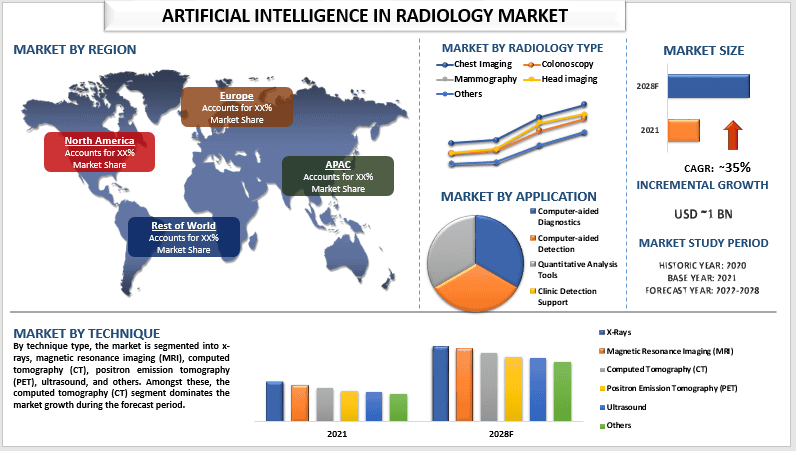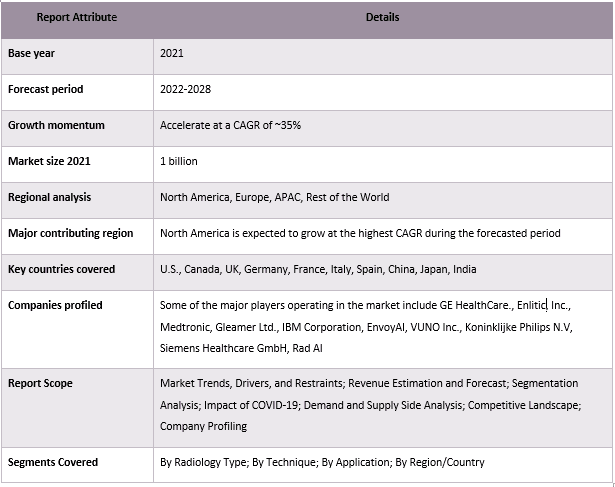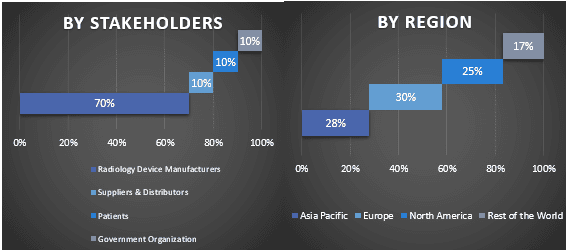Рынок искусственного интеллекта в радиологии: текущий анализ и прогноз (2022-2028 гг.)
Акцент на типе радиологии (визуализация грудной клетки, колоноскопия, маммография и визуализация головы) по методике (рентгеновское излучение, магнитно-резонансная томография (МРТ), компьютерная томография (КТ), позитронно-эмиссионная томография (ПЭТ), ультразвук и прочее) по применению (системы автоматизированной диагностики, системы автоматизированного обнаружения, инструменты количественного анализа и поддержка клинической диагностики) и региону/стране

Объем рынка искусственного интеллекта в радиологии оценивался примерно в 1 миллиард долларов США в 2021 году и, как ожидается, будет расти в среднем на ~35% в период с 2022 по 2028 год. Рост распространенности хронических заболеваний привел к повышению осведомленности людей о ранней диагностике. Это привело к увеличению рабочей нагрузки на рентгенологов. Радиология на основе искусственного интеллекта обеспечивает своевременные результаты с высокой точностью и эффективностью. Кроме того, увеличению рынка способствует рост государственного финансирования для ускорения исследований в области технологий здравоохранения на основе искусственного интеллекта. Например, согласно отчету Министерства здравоохранения и социального обеспечения Великобритании за 2023 год, около 123 миллионов фунтов стерлингов было инвестировано в 86 решений на основе искусственного интеллекта в течение трех раундов присуждения премий, которые помогли более чем 300 000 пациентам и улучшили их лечение и уход при хронических заболеваниях. Таким образом, ожидается, что рост распространенности хронических заболеваний и повышение спроса на раннюю диагностику будут способствовать росту рынка в течение прогнозируемого периода.
В число основных игроков, работающих на рынке, входят GE HealthCare., Enlitic, Inc., Medtronic, Gleamer Ltd., IBM Corporation, EnvoyAI, VUNO Inc., Koninklijke Philips N.V, Siemens Healthcare GmbH, Rad AI
Информация, представленная в отчете
«Ожидается, что среди типов радиологии сегмент маммографии будет расти со значительным среднегодовым темпом роста в течение прогнозируемого периода»
По типу радиологии рынок сегментирован на рентгенографию грудной клетки, колоноскопию, маммографию, визуализацию головы и другие. Ожидается, что сегмент маммографии будет расти в течение прогнозируемого периода. Это связано с ростом заболеваемости раком молочной железы и повышением осведомленности женщин о ранней диагностике во всем мире. Например, по данным FDA, количество монографий, выполняемых каждый год, составляет 40 миллионов. Кроме того, искусственный интеллект использует компьютерную систему обнаружения, которая определяет изменения в маммограммах и может выявлять отклонения за год до того, как будет диагностирован рак. Ожидается, что эти элементы ускорят рост этого сегмента
«Среди типов методов в 2021 году наибольшую долю рынка занимала компьютерная томография»
По типу метода рынок сегментирован на рентгеновские лучи, магнитно-резонансную томографию (МРТ), компьютерную томографию (КТ), позитронно-эмиссионную томографию (ПЭТ), ультразвук и другие. Среди них наибольшую долю в течение прогнозируемого периода занимал сегмент компьютерной томографии (КТ). A.I. способен значительно снизить дозу радиации, получаемую пациентом при компьютерной томографии (C.T.), за счет автоматизации и оптимизации процедур сбора данных, таких как размещение пациента и настройки параметров получения. Участники рынка вносят инновации для удовлетворения растущего спроса на КТ-сканирование в исследовательской отрасли. Например, в августе 2022 года компания Xoran Techechnolgies объявила об одобрении FDA 510(k) для For TRON, полнотелой системы флюороскопической компьютерной томографии, предназначенной для обеспечения безопасной, сверхвысокой разрешающей способности и низкой дозы облучения в традиционных условиях, таких как отделения интенсивной терапии.
«Среди приложений в 2021 году на рынке доминируют компьютерные средства диагностики»
По приложениям рынок сегментирован на компьютерную диагностику, компьютерное обнаружение, инструменты количественного анализа и поддержку клинического обнаружения. Среди них на рынке доминирует компьютерная диагностика. Благодаря интеграции искусственного интеллекта и быстрому развитию технологий здравоохранения, таких как передовая биоэлектроника, биомеханика и т. д. Кроме того, система, основанная на искусственном интеллекте, обеспечивает быстрые результаты с высокой точностью и прецизионностью.
«В 2021 году на рынке искусственного интеллекта в радиологии доминировала Северная Америка»
Северная Америка доминирует в регионе, что связано с хорошо развитой инфраструктурой здравоохранения региона, которая позволяет внедрять инновационные технологии. Кроме того, компании в области искусственного интеллекта привлекают наибольшее инвестиционное внимание, и ожидается, что сектор в Северной Америке будет быстро развиваться. Например, в 2022 году берлинский стартап Vara, занимающийся скринингом рака молочной железы с помощью искусственного интеллекта, получил 4,5 миллиона евро в качестве расширения финансирования серии A. Этот раунд увеличивает общий объем инвестиций серии A до 11 миллионов евро. Таким образом, вышеупомянутый фактор, как ожидается, будет способствовать росту рынка в течение прогнозируемого периода.
Охват отчета об искусственном интеллекте на рынке радиологии

Причины купить этот отчет:
- Исследование включает в себя анализ размера и прогнозирования рынка, проверенный аутентифицированными ключевыми экспертами отрасли.
- Отчет представляет собой краткий обзор общих показателей отрасли с первого взгляда.
- Отчет охватывает углубленный анализ видных представителей отрасли с основным упором на ключевые финансовые показатели бизнеса, портфели продуктов, стратегии расширения и последние разработки.
- Подробное изучение факторов, ограничений, ключевых тенденций и возможностей, преобладающих в отрасли.
- Исследование всесторонне охватывает рынок по различным сегментам.
- Глубокий анализ отрасли на региональном уровне.
Варианты настройки:
Глобальный рынок искусственного интеллекта в радиологии может быть дополнительно настроен в соответствии с требованиями или любым другим сегментом рынка. Кроме того, UMI понимает, что у вас могут быть свои собственные бизнес-потребности, поэтому не стесняйтесь обращаться к нам, чтобы получить отчет, который полностью соответствует вашим требованиям.
Содержание
Методология исследования рынка искусственного интеллекта в радиологии (2022-2028 гг.)
Анализ исторического рынка, оценка текущего рынка и прогнозирование будущего рынка глобального рынка искусственного интеллекта в радиологии были тремя основными этапами, предпринятыми для создания и анализа внедрения искусственного интеллекта в радиологии в основных регионах мира. Было проведено тщательное вторичное исследование для сбора исторических данных о рынке и оценки текущего размера рынка. Во-вторых, для подтверждения этих выводов было принято во внимание множество результатов и предположений. Кроме того, были проведены исчерпывающие первичные интервью с отраслевыми экспертами по всей цепочке создания стоимости глобального рынка искусственного интеллекта в радиологии. После предположения и подтверждения рыночных показателей посредством первичных интервью мы применили подход «сверху вниз/снизу вверх» для прогнозирования общего размера рынка. После этого были приняты методы разбивки рынка и триангуляции данных для оценки и анализа размера рынка сегментов и подсегментов соответствующей отрасли. Подробная методология описана ниже
Анализ исторического размера рынка
Этап 1: Углубленное изучение вторичных источников:
Было проведено подробное вторичное исследование для получения исторических данных о размере рынка искусственного интеллекта в радиологии через внутренние источники компании, такие как годовые отчеты и финансовые отчеты, презентации о деятельности, пресс-релизы и т. д., и внешние источники, включая журналы, новости и статьи, правительственные публикации, публикации конкурентов, отраслевые отчеты, сторонние базы данных и другие надежные публикации.
Этап 2: Сегментация рынка:
После получения исторических данных о размере рынка искусственного интеллекта в радиологии мы провели подробный вторичный анализ для сбора исторических данных о рынке и доли для различных сегментов и подсегментов для основных регионов. Основные сегменты, включенные в отчет, включают тип радиологии, технику и применение. Кроме того, был проведен анализ на уровне стран для оценки общего внедрения моделей тестирования в этом регионе.
Этап 3: Факторный анализ:
После получения исторических данных о размере рынка различных сегментов и подсегментов мы провели подробный факторный анализ для оценки текущего размера рынка искусственного интеллекта в радиологии. Кроме того, мы провели факторный анализ с использованием зависимых и независимых переменных, таких как тип радиологии, техника и применение искусственного интеллекта в радиологии. Был проведен тщательный анализ сценариев спроса и предложения с учетом ведущих партнерств, слияний и поглощений, расширения бизнеса и запуска продуктов в секторе искусственного интеллекта в радиологии по всему миру.
Оценка текущего размера рынка и прогноз
Определение текущего размера рынка: На основе действенных идей, полученных на основе вышеуказанных 3 этапов, мы определили текущий размер рынка, ключевых игроков на глобальном рынке искусственного интеллекта в радиологии и доли рынка сегментов. Все необходимые процентные доли разделения и разбивки рынка были определены с использованием вышеупомянутого вторичного подхода и были проверены посредством первичных интервью.
Оценка и прогнозирование: Для оценки и прогнозирования рынка различным факторам, включая движущие силы и тенденции, ограничения и возможности, доступные для заинтересованных сторон, были присвоены веса. После анализа этих факторов были применены соответствующие методы прогнозирования, т. е. подход «сверху вниз/снизу вверх», чтобы получить прогноз рынка на 2028 год для различных сегментов и подсегментов на основных рынках по всему миру. Методология исследования, принятая для оценки размера рынка, включает в себя:
- Размер рынка отрасли с точки зрения выручки (в долларах США) и темпы внедрения искусственного интеллекта в радиологии на основных рынках внутри страны
- Все процентные доли, разделения и разбивки сегментов и подсегментов рынка
- Ключевые игроки на глобальном рынке искусственного интеллекта в радиологии с точки зрения предлагаемых продуктов. Кроме того, стратегии роста, принятые этими игроками для конкуренции на быстрорастущем рынке
Подтверждение размера рынка и доли
Первичное исследование: Были проведены углубленные интервью с ключевыми лидерами мнений (KOL), включая руководителей высшего звена (CXO/VP, руководитель отдела продаж, руководитель отдела маркетинга, руководитель операционного отдела, региональный руководитель, руководитель страны и т. д.) в основных регионах. Затем результаты первичных исследований были обобщены, и был проведен статистический анализ для доказательства заявленной гипотезы. Данные первичных исследований были объединены с вторичными результатами, что позволило превратить информацию в полезные сведения.
Распределение основных участников по различным регионам

Инжиниринг рынка
Метод триангуляции данных был использован для завершения общей оценки рынка и получения точных статистических данных для каждого сегмента и подсегмента глобального рынка искусственного интеллекта в радиологии. Данные были разделены на несколько сегментов и подсегментов после изучения различных параметров и тенденций в областях продукта, технологии и конечных пользователей на глобальном рынке искусственного интеллекта в радиологии.
Основная цель исследования глобального рынка искусственного интеллекта в радиологии
В исследовании были точно определены текущие и будущие рыночные тенденции глобального рынка искусственного интеллекта в радиологии. Инвесторы могут получить стратегические идеи, чтобы основывать свои решения для инвестиций на качественном и количественном анализе, выполненном в исследовании. Текущие и будущие рыночные тенденции определили общую привлекательность рынка на региональном уровне, предоставив платформу для промышленного участника для использования неиспользованного рынка и получения выгоды от преимущества первопроходца. Другие количественные цели исследований включают:
- Проанализировать текущий и прогнозируемый размер рынка искусственного интеллекта в радиологии с точки зрения стоимости (в долларах США). Кроме того, проанализировать текущий и прогнозируемый размер рынка различных сегментов и подсегментов
- Сегменты в исследовании включают области типа радиологии, техники и применения
- Определение и анализ нормативно-правовой базы для искусственного интеллекта в радиологии
- Анализ цепочки создания стоимости, связанной с присутствием различных посредников, а также анализ поведения клиентов и конкурентов отрасли
- Проанализировать текущий и прогнозируемый размер рынка искусственного интеллекта в радиологии для основного региона
- Основные страны регионов, изученных в отчете, включают Азиатско-Тихоокеанский регион, Европу, Северную Америку и остальной мир
- Профили компаний, занимающихся искусственным интеллектом в радиологии, и стратегии роста, принятые участниками рынка для поддержания устойчивости на быстрорастущем рынке
- Углубленный анализ отрасли на региональном уровне
Связанные Отчеты
Клиенты, купившие этот товар, также купили










